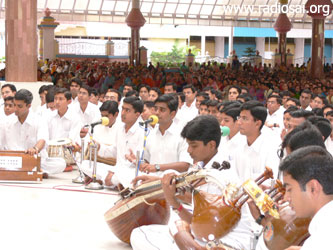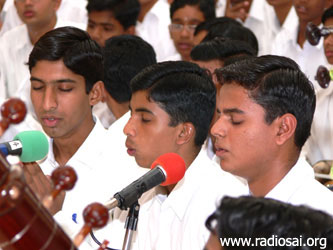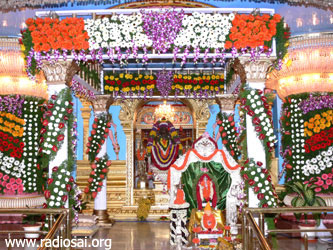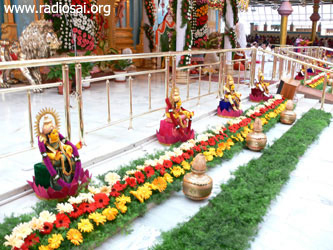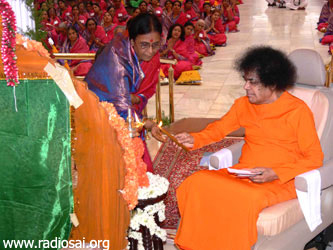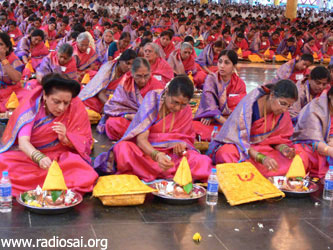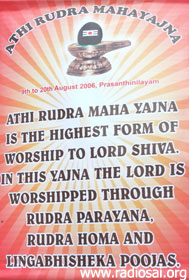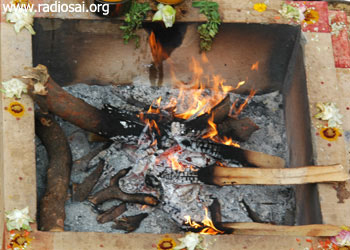|
PRASHANTI DIARY CHRONICLES OF HEAVEN ON EARTH As probably most of you know by now, the biggest happening last month in Prashanti Nilayam was the Ati Rudra Maha Yagnam, a 12 day long celebration on a scale rarely witnessed in history, a celebration that was unprecedented as for the first time a yagnam or “sacrifice” to Lord Shiva was offered in the presence of the Living God Himself. The tone for this momentous event was set quite a few days earlier, on July 30, 2006, when the students of the Sai Mirpuri College of Music celebrated in song the role of Lord Shiva in the birth of Music. This was followed a few days later by the Varalakshmi Puja, a puja (prayer) which history states was revealed by Lord Shiva to Mother Parvathi when She asked Him to give a boon to all married women for the well being and prosperity of their husbands. These two events, memorable and important in their own right, set everyone’s thoughts this month to the munificence of Lord Shiva and all that He has done and continues to do for the benefit of humanity. This was fittingly followed by the Ati Rudra Maha Yagnam, a unique form of worship of Lord Shiva performed to establish an environment supremely conducive for spiritual growth and for the washing away of one’s sins. This holy ritual was also a prayer for the prosperity and protection of mankind (loka kalyanam and loka kshemam) and also satisfies worldly desires which if used virtuously can confer a lot of spiritual merit. JULY 30, 2006: “SANGEETHA NAIVEDYAM” - A VOCAL AND INSTRUMENTAL FUSION PROGRAMME This program, a vocal and instrumental fusion program that was lovingly offered by the Music College students, started with a Ganesh stuthi entitled “Naada Pushpanjali”.
From the scales of the Sama Veda innumerable ragas emerged and then from the divine damaru (small two-headed drum) of Lord Shiva emerged 5 rhythmic patterns – Thisra, Chaturasram, Khandam, Misram and Sankeernam. “Rudra Tandava”, presented next by the boys, depicted the birth of these ‘swaras’ and ‘talas’. This was a fusion of the popular song on Shiva – Bho shambho Shiva Shambo Svayambo in raag Revathy, and the bhajan Bhasmabooshi thaangaa Sai with rhythmic varieties. The instruments used in this piece were the veena, the mridangam, the tavil, the harmonium, the kanchira, the keyboard and the octopad. The third item they presented was a thillana (Naa diri diri dheem than a na) in raag Kadanakuthuhalam, a raga that gives joy. And their last song for the evening was a famous Western composition called “Heartbeat” by Sri Muthiyah Bhagavather in raag Sankara Bharanam. ‘Heartbeat’ was sung with the accompaniments of the veena and the mridangam. All in all it was an enjoyable evening, a fitting precursor to the magnificent Ati Rudra Maha Yagnam to follow in a few days.
AUG 4th: VARALAKSHMI PUJA IN SAI KULWANT HALL In August 2000, Swami explained about the origins of the Varalakshmi Puja. Swami said, "Legend has it that Parvati once asked Easwara (i.e. Lord Shiva) if there was any way to ensure the auspiciousness, prosperity and well-being of women. She desired that every woman should lead a long, happy and healthy life with her husband, children, grandchildren, friends and relatives. Easwara was pleased with Parvati’s prayer and told her about the Varalakshmi Vrata, which would confer all a woman may ask for. This particular Vrata is a boon for all women." "Easwara revealed the sacred Varalakshmi Vrata to Parvati, so that future generations might perform this Vrata and derive the benefits there from. The Purohit (chief priest) has enumerated the benefits which this Vrata confers. When a woman performs the Varalakshmi Vrata, she gets the blessings that she may live long with plenty and prosperity as a sumangali (a woman whose husband is alive) with her children and grandchildren. Varalakshmi protects seven past generations and seven future generations. Noble women like Savitri and Anasuya enjoyed peace and prosperity by performing this sacred Vrata. The purpose of Varalakshmi Vrata is to atone your sins, develop sacredness and ultimately lead you to Divinity."
On August 4th, 2006, another grand Varalakshmi Puja was performed in the divine presence for the second year in a row. This year nearly 1500 women from all over India as well as from abroad participated in this function held in the divine presence to pray for the well being of their husbands and their families. Sai Kulwant Hall was beautifully decorated this day with pieces of lawn and with small Lakshmi Statues adorning the steps of the veranda. The centre of the veranda dais, right in front of Ganesha was done up as a floral pandal (protective structure) resting on 4 columns wherein a beautiful silver statue of Goddess Lakshmi was installed. On either side of the veranda a floral portrait of Mother Lakshmi, done by using flower petals of different hues, was also placed to lend the right ambience to this holy day.
AUG 9th to 20th, 2006: THE ATHI RUDRA MAHA YAGNA
Then finally dawned the day that devotees from all over the world and deities in Heaven, were waiting for with bated breath – the Ati Rudra Maha Yagnam. A lot of the background material on this yagnam has already been reported in numerous forums earlier and this event also forms this month’s cover story on Heart2Heart, but for the sake of continuity as well as completeness of this article we will digress a bit to give a brief back-ground (even at the risk of repetition) in order to link all the aspects of the story we want to tell you about this momentous event. We seek the readers’ understanding of our indulgence.
"Having created men along with yagya, the Lord of Creation (Prajapati) said: 'By yagya you will prosper and its performance will bring forth the fulfilment of your desires. Through yagya you nourish and sustain the gods and those gods will, in turn, sustain you. By sustaining one another, you will attain the highest good. Nourished by the sacrifice, the gods will bestow on you the enjoyments you desire. But he who enjoys their gifts without offering to them is merely a thief.'" Why is fire used? There are also two reasons for the use of fire as the preferred means of conveyance of the essence of the yaga or (yagya) to these deities.
Rudram is another name for Lord Shiva. One who removes difficulties, one who teaches ‘Atmavidya’, one who uplifts dharma, one who grants emancipation, one who grants wisdom and even one who on doomsday punishes evil-doers is called Rudra. The term Rudra is commonly (and mistakenly) associated only with the angry aspect of Lord Shiva, the aspect with which He destroys evil, though Lord Rudra is expressly concerned with the total well being, protection and emancipation of humankind. The Sri Rudram chant (called the Namakam) is an ancient Vedic hymn, and is the oldest example of a listing of various names of Lord Siva. Through the chanting of the Namakam, Lord Siva's various attributes and aspects are invoked and worshipped. Describing the several facets of Lord Shiva by reciting the Namakam is also called ‘Rudra Prasna’. The Rudra prasna can be done with or without the accompaniment of a Vedic yagna ritual. When accompanied with the Vedic fire ritual, it is called the Rudra Homam or the Rudra Yagnam. In the Taithareeya Samhita, 4th skanda (chapter) – the 7th sub-stanza is known as ‘Chamaka’. In this section, the letters ‘cha’ and ‘mey’ appear repeatedly and it is hence known as Chamaka. Those who are interested in worldly gains and riches, pray to God to grant them all types of ‘boons’ and hence this prayer is known as the ‘Chamakam’.
|
||||||||||||||||||||||||||||||||||||||||||||||||||||||
